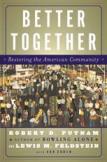Beneficial Networking
With another presidential election looming on the horizon, voter turnout will be a major public issue. Political participation, however, is just one measure of civic engagement and social capital. Other measures, ranging from volunteering and religious leadership to civic leadership and trust between races, are also vital community assets. This territory was explored in considerable detail when Robert Putnam published Bowling Alone: The Collapse and Revival of American Community in 2000.
Writing in Bowling Alone, Putnam, a political scientist at Harvard University, noted that social capital refers to connections among individualssocial networks and the norms of reciprocity and trustworthiness that arise from them, while civic engagement concerns people’s connections with the life of their communities, not just with politics. He contended that the decades-long trends of civic disengagement were caused by such factors as pressures of time and money, mobility and sprawl, technology and mass media, and generational differences. And as he acknowledged during a recent speech in Seattle, he ended Bowling Alone on a somewhat gloomy note.
Three years after that much-discussed book appeared, Putnam has joined with Lewis Feldstein to produce the more upbeat Better Together: Restoring the American Community. Feldstein, president of the New Hampshire Charitable Foundation, is a long-time collaborator with Putnam in the Saguaro Seminar, a national blue-ribbon think tank of community leaders who have been working on civic engagement and social capital questions for many years.
Better Together is a response to readers of Bowling Alone who wanted to improve their own communities. It is not, however, a cookbook for community improvement, but rather a storybook of instruction and inspiration. There are stories to hold the interest of a wide array of readers. The authors present compelling insights from diverse settings that range from workplaces (U.P.S. and Harvard) and whole communities (Portsmouth, N.H., and Portland, Ore.) to community institutions (libraries and schools) and virtual communities (craigslist.org).
Putnam and Feldstein will disappoint those who seek a quick fix for social capital deficits. Indeed, they cite Max Weber’s observation that social change requires a strong and slow boring of hard boards. The authors present a particularly bracing reminder that communities cannot change overnight, as illustrated by three cases (Boston, Portland and Tupelo, Miss.) that come the closest to providing a how-to-do-it guide for other community leaders.
The two-decade Dudley Street Neighborhood Initiative in Boston was a well-organized grass-roots effort that literally caused a foundation to change its giving philosophy from multiple small grants to a single focus. Moreover, it illustrates how a community will resist an externally imposed plan but will embrace and implement (with enthusiasm) a resident-controlled plan. This initiative transformed a blighted area into a village of relationships with new homes, playgrounds, gardens, businesses and a community center.
The 30-plus years of neighborhood-based work in Portland is described as a positive epidemic of civic engagement. The city created an Office of Neighborhood Associations to support the key contributions of those groups. Over time, riverfront redevelopment, light rail transit and boundary limits on urban growth have emerged from, and contributed to, strong social capital.
The 60-year economic development effort in Tupelo, Miss., as Putnam recounts, traces the county’s improvement from one of the poorest in the nation to one whose poverty rate today is one-half the national average. As is often the case, a single individual (in this instance, the newspaper publisher) was the catalyst for community transformation. He used the networks around him and worked with people who trusted each other. By treating the town and the region as an interdependent community, this network took the long view, and now hosts community leaders from across the nation who want to learn how to replicate this success story.
Readers of America may be especially interested in the religious foundations of the Valley Interfaith and Saddleback Church examples, although for very different reasons. Operating in the desperately poor and officially ignored colonias of the Rio Grande Valley in Texas, Valley Interfaith has built on the work of Ernesto Cortés and the Southwest Industrial Areas Foundation. By holding accountability sessions with elected officials, people have been able to learn by leading.
Saddleback Church, in Lake Forest, Calif., will probably evoke multiple responses. On the one hand, any effort that enlists 45,000 members through a target audience approach that offers multiple small-group entry points (discussion and other special-interest affinity groups) is clearly an impressive achievement in marketing. On the other hand, those who are regular participants in more liturgically oriented denominations may find crowd pleasing services conducted on a concert stage in a 3,000-seat sanctuary with a large video screen backdrop to be a challenging concept.
Better Together has two primary messages: small-scale changes are easier to achieve than sweeping systemic improvements, and people support that which they help to create. Both messages are important ones for every community in the nation.
This article also appeared in print, under the headline “Beneficial Networking,” in the March 8, 2004, issue.








